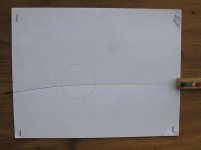I hope this is useful.:grin:
More than useful to me. I was thinking of doing the same sort of thing, but you saved me a bunch of time. :wink:
Your little device is a very elegant proof of what we all know (almost all of us anyway). A perfect pendulum stroke delivers a straight cue right up to the contact point with the CB. After that, the natural motion of the arm raises the butt of the cue, causing the tip to drop to the cloth due to gravity... provided that you have a cradle grip that suspends the cue from the thumb and first or second finger somewhere behind the balance point of the cue. This tip action during the follow through can easily be seen just by stroking the cue to its natural finish without a CB in front of it.
I added a bright green line in Photoshop using the "line tool". How much straighter could you possibly get your stroke" Arcs? Malarkey! That stroke line is about a pencil line width away from the computer-drawn line at its maximum, with a sweet spot a measured 5" long. I propose to English! that he make a similar device, but with an articulated shoulder section added to it. Maybe he can show us all just how easy it is to refine that "huge" arc into a dead-straight line using two moving joints instead of one. Lol
Attachments
Last edited:



